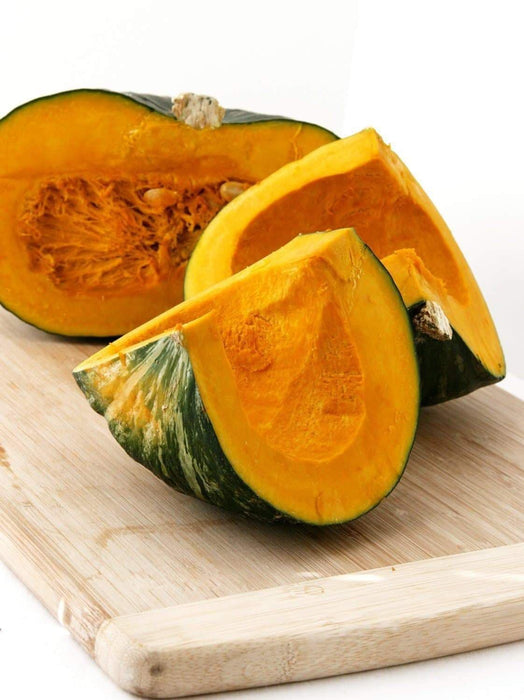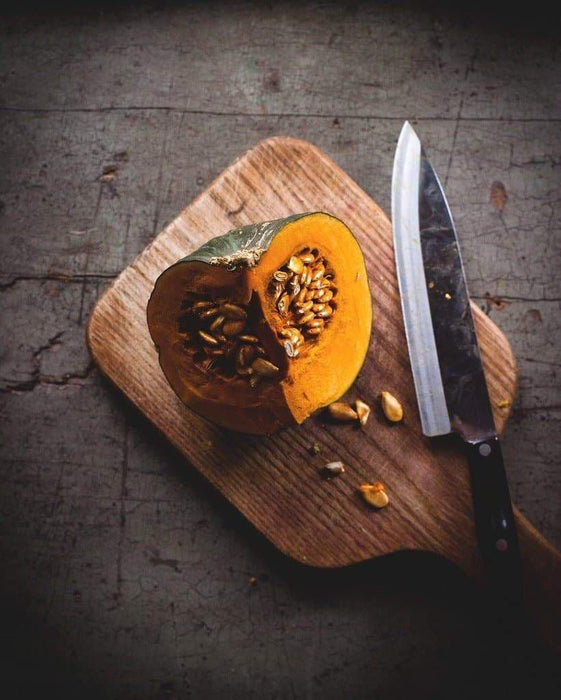
Kabocha Squash SEEDS, Japanese pumpkin ,ASIAN VEGETABLE
Original price
$ 4.36
-
Original price
$ 18.66
Original price
$ 4.36
$ 4.36
-
$ 18.66
Current price
$ 4.36
Most orders are processed by the next day
Select your desired size and/or color from the available options.
Kabocha,Japanese pumpkin (Cucurbita moschata) Open pollinated, heirloom, Organically grown and hand Harvest !
kabocha, in other parts of the country itâs known as butternut squash or Japanese pumpkin. No matter what you call it, it is an easy vegetable to grow and a hearty vegetable to eat.
Despite being considered a Japanese vegetable, this type of squash was probably domesticated in Central or South America. It is now grown throughout the Pacific and is very popular in Hawaii. And with good reason â it is very adaptable and can grow in many situations, from coastal to upland areas.
Kabocha on a fence.
It has a dark green or gray-green or orange skin with a rich golden yellow or orange-yellow flesh. Unlike many squash, the flesh is rich and flavorful. Kabocha can be substituted for pumpkin in recipes, or prepared Japanese style or like any other butternut squash.
Cultivation
As mentioned above, this type of squash can grow pretty much anywhere you have the space. âSpaceâ is the key word here. It is a vining plant that climbs via tendrils, rather than twining its stems around supports.
Although it can be grown sprawling along the ground, I have much better luck with it, and get better-formed fruit, if I grow it on some sort of support. Iâve used fences, bamboo stakes formed into a tipi, and the stems left behind after trimming back pigeon pea bushes. Some people recommend the fruit be supported with some sort of netting but I find that its stems easily support kabocha fruit as long as there is a solid support for those stems. The tendrils are quite strong and if they have something to wrap around, theyâll keep the fruit up and off the ground.
Kabocha vines easily grow 10 to 15 feet long, so no matter what you decide to grow them on, they do need space. If you decide to let them sprawl, give them plenty of room to spread. They are annual plants, so they wonât be in any one place for long (they tend to die after producing a few fruit per plant).
Although they arenât too particular as to soil type, they do prefer rich, well-drained soil. Plant squash after a bean crop to take advantage of the nitrogen left behind by the legumes. It is never a bad idea to use as much compost as you have on hand to enrich the soil and improve with the drainage (if the natural soil is clay) or the water-holding capacity (if itâs sandy). If you really feel the need to use chemical fertilizers then use a fertilizer balanced for fruit or vegetables.
Find a place that has full sun or at least six hours of direct sunlight a day. It is also best if there is good air circulation. The lower leaves will inevitably get pretty ratty, but this doesnât matter, just ignore it.
Kabocha, like other cucumber relatives, does like itâs water and can look wilted in the middle of the day. Where I garden, I donât need to irrigate my kabocha unless it hasnât rained for a couple of weeks, but in general, deeply irrigate with about 1 inch of water per week, unless itâs raining.
The sturdy stems are perfectly capably of holding up the fruit untilthey mature. Just make sure the supporting structure is strong.
Like other plants in the cucumber/squash family of vegetable, the male flowers appear first, followed by females with a male here and there.
They are dependent on pollinators, but most of our pollinating insects are attracted to the big yellow flowers.
If you are one of those people who spray for insects constantly for whatever reason, stop that! Or at least make sure whatever you are spraying is bee safe and targeted only for the pests you want to control. Not all insects are bad and these plants wonât produce without them (unless you want to be the bee and go out and hand pollinate).
If your plants are flowering nicely but the fruit turn yellow and drops when it less than an inch in diameter, itâs probably not getting pollinated.
Materials: Organic,Kabocha Squash,Japanese pumpkin,Seed,Annual Garden Vegetable,Sweet,creamy Select your desired size and color from the available option
kabocha, in other parts of the country itâs known as butternut squash or Japanese pumpkin. No matter what you call it, it is an easy vegetable to grow and a hearty vegetable to eat.
Despite being considered a Japanese vegetable, this type of squash was probably domesticated in Central or South America. It is now grown throughout the Pacific and is very popular in Hawaii. And with good reason â it is very adaptable and can grow in many situations, from coastal to upland areas.
Kabocha on a fence.
It has a dark green or gray-green or orange skin with a rich golden yellow or orange-yellow flesh. Unlike many squash, the flesh is rich and flavorful. Kabocha can be substituted for pumpkin in recipes, or prepared Japanese style or like any other butternut squash.
Cultivation
As mentioned above, this type of squash can grow pretty much anywhere you have the space. âSpaceâ is the key word here. It is a vining plant that climbs via tendrils, rather than twining its stems around supports.
Although it can be grown sprawling along the ground, I have much better luck with it, and get better-formed fruit, if I grow it on some sort of support. Iâve used fences, bamboo stakes formed into a tipi, and the stems left behind after trimming back pigeon pea bushes. Some people recommend the fruit be supported with some sort of netting but I find that its stems easily support kabocha fruit as long as there is a solid support for those stems. The tendrils are quite strong and if they have something to wrap around, theyâll keep the fruit up and off the ground.
Kabocha vines easily grow 10 to 15 feet long, so no matter what you decide to grow them on, they do need space. If you decide to let them sprawl, give them plenty of room to spread. They are annual plants, so they wonât be in any one place for long (they tend to die after producing a few fruit per plant).
Although they arenât too particular as to soil type, they do prefer rich, well-drained soil. Plant squash after a bean crop to take advantage of the nitrogen left behind by the legumes. It is never a bad idea to use as much compost as you have on hand to enrich the soil and improve with the drainage (if the natural soil is clay) or the water-holding capacity (if itâs sandy). If you really feel the need to use chemical fertilizers then use a fertilizer balanced for fruit or vegetables.
Find a place that has full sun or at least six hours of direct sunlight a day. It is also best if there is good air circulation. The lower leaves will inevitably get pretty ratty, but this doesnât matter, just ignore it.
Kabocha, like other cucumber relatives, does like itâs water and can look wilted in the middle of the day. Where I garden, I donât need to irrigate my kabocha unless it hasnât rained for a couple of weeks, but in general, deeply irrigate with about 1 inch of water per week, unless itâs raining.
The sturdy stems are perfectly capably of holding up the fruit untilthey mature. Just make sure the supporting structure is strong.
Like other plants in the cucumber/squash family of vegetable, the male flowers appear first, followed by females with a male here and there.
They are dependent on pollinators, but most of our pollinating insects are attracted to the big yellow flowers.
If you are one of those people who spray for insects constantly for whatever reason, stop that! Or at least make sure whatever you are spraying is bee safe and targeted only for the pests you want to control. Not all insects are bad and these plants wonât produce without them (unless you want to be the bee and go out and hand pollinate).
If your plants are flowering nicely but the fruit turn yellow and drops when it less than an inch in diameter, itâs probably not getting pollinated.
Materials: Organic,Kabocha Squash,Japanese pumpkin,Seed,Annual Garden Vegetable,Sweet,creamy Select your desired size and color from the available option
LET OUR CUSTOMER SPEAK FOR US

![[Seeds] - Caribbeangardenseed](http://caribbeangardenseed.com/cdn/shop/files/gift-card-gift-card-1_1024x1024_dfa857db-9150-4315-a362-7f0bb3fb9c47_60x28.png?v=1703978838)



